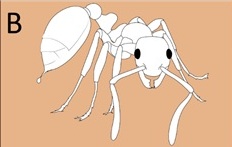To date, around 71% of all described ant species have been found to sting or spray secretions from their venom glands. Some spray acid such as Formica mound building ants (clip from Life in the Undergrowth – Supersocieties by David Attenborough):
while others inject venom like the red imported fire ant Solenopsis invicta (video by Brave Wilderness channel):
Still other species wipe or paint their victim with poison and can dispense it like a smelly gas into the air. The toxic cocktail of organic compounds that make up ant venom is diverse. The venom of some species contains peptides and proteins, but these molecules typically only constitute 0.1-5% of the total venom extract. Instead, many species of ants depend upon alkaloids, a group of organic compounds defined by a heterocyclic ring containing a nitrogen atom. First discovered in ants in 1970, a diversity of venom alkaloids has been found throughout the subfamily Myrmicinae, with six structural classes represented and various differences in the substituents or side chains attached to the main molecule.
Why study ant venom?
Venoms have been found throughout all major animal phyla and play important roles in a number of ecological interactions, especially in predator-prey relationships where they are used as offensive or defensive chemical weaponry. While the venom alkaloids of many ant species have been identified and characterized, the biological activities of these compounds have only been investigated in a minority of groups. Alkaloids are presently known to have adverse toxic effects on a range of organisms; for example, the major component of S. invicta venom has not only been shown to act as a toxin on predatory and prey animal taxa but also possesses herbicidal and antimicrobial properties. Additionally, some alkaloids have been demonstrated to be utilized in a non-toxic capacity and serve communicative functions as well.
One of the goals of the Adams Lab here at OSU is to understand the biological functions and properties of the various venomous alkaloids of ants, and an area of active research has been within the genus Megalomyrmex. Although the majority of species are free-living predators, some are social parasites that infiltrate the colonies of fungus-farming ants. They consume host brood and fungus garden by dominating the farmers with their alkaloidal weaponry. A well-documented example of this interspecific interaction has been between the parasitic Megalomyrmex symmetochus and its host Sericomyrmex amabilis, in which the venom of M. symmetochus is a crucial component in the aggressive interactions that take place throughout the establishment and maintenance of the host-parasite relationship.
During these aggressive interactions, M. symmetochus ants often use three main types of alkaloid dispensing behaviors: gaster flagging, side-swipe sting, and gaster-tuck sting.
A) Gaster flagging is when M. symmetochus ants vibrate their gaster at approximately a 45-degree angle with a drop of alkaloid venom at the tip. This allows for the venom to be dispersed into the air at a low concentration, and is thought to be a warning to their host ants to deter them from attacking, acting as both a visual and chemical signal.
B) Side-swipe sting is when M. symmetochus’ gaster is waved from the side towards the host, dispensing the venom directly onto the host ant.
C) Gaster-tuck sting is when the gaster is tucked under the body in between the legs towards the host ant, dispensing venom directly onto the host (see illustrations below for a visual representation of these behaviors).
However, the interactions between these species are not always aggressive, and in some cases the M. symmetochus parasites act like mercenaries and protect their host from a more lethal ant species – watch them in action (video by Rachelle Adams, Assistant Professor in the OSU department of EEOBiology):
Our future research will continue exploring ant venoms in a broader context. The Adams Lab will be traveling to Panama to collect and observe Megalomyrmex species in their natural habitats as well as conduct experiments to gain greater insight into their biology. Look for our future blogs from Gamboa, Panama at the Smithsonian Tropical Research Institute in May!
For a more in-depth look at the relationship between M. symmetochus and S. amabilis, check out Dr. Adams’ article in the USA Proceedings of the National Academy of Sciences entitled “Chemically armed mercenary ants protect fungus-farming societies.” And to learn more about the venom of the red imported fire ant Solenopsis invicta, watch this video by Eric Keller.
Visit us at the Museum of Biological Diversity’s Open House on April 22nd to learn more about our research! We will have live fungus-growing ants!
Acknowledgements: We would like to thank Rozlyn E. Haley for the ant illustrations.
Reference: Adams, R. M., Liberti, J., Illum, A. A., Jones, T. H., Nash, D. R., & Boomsma, J. J. (2013). Chemically armed mercenary ants protect fungus-farming societies. Proceedings of the National Academy of Sciences, 110(39), 15752-15757.
 About the Authors: Conor Hogan is a graduate student in Rachelle Adams’ lab and Mazie Davis is an undergraduate student who did a research project on parasitic ant stinging behaviors in Rachelle Adams’ lab in 2016.
About the Authors: Conor Hogan is a graduate student in Rachelle Adams’ lab and Mazie Davis is an undergraduate student who did a research project on parasitic ant stinging behaviors in Rachelle Adams’ lab in 2016.
*** We would like to hear from you – Please leave a comment ***


